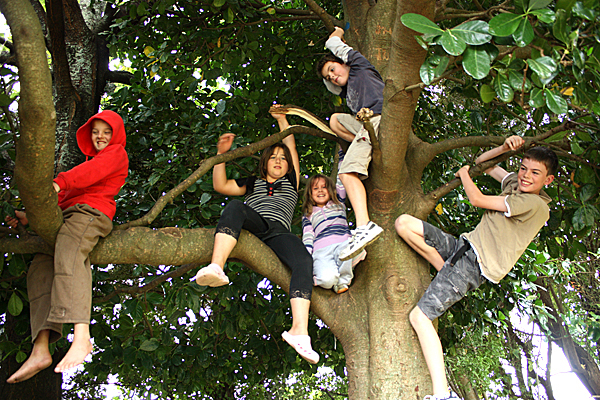 Schools have changed some since we were kids, but you can bet teachers admonishing students, especially young ones, to “sit still” haven’t budged a bit.
Schools have changed some since we were kids, but you can bet teachers admonishing students, especially young ones, to “sit still” haven’t budged a bit.
Out in the “wild”, I hear the same scolding from parents too.
Setting strict boundaries for our children is a great idea. Telling them to stop moving? Not so much.
And there are myriad reasons to let our children move.
The First World Has a Movement Problem
Yelling “sit still” definitely results in more sedentary children (that’s sorta the point). Those sedentary children are more likely to become sedentary adults. And whether you’re looking at adults or children, “sedentary” is a big problem in developed countries.
Here in the U.S., more than a third of children are overweight, and 1 in 6 are full-blown obese[1]. And their parents? Almost 35% of American adults are now obese.
Around these parts, we fully recognize that “Eat less and move more” is bad advice. But “sit still” is even worse. We all recognize that movement is vital to health, but we (Americans) fall disgustingly short of achieving healthy movement.
Only 1 in three children is physically active each day[2]. That’s dismal, but they’re doing much better than their parents – less than 5% of American adults achieve that[3]. For those kids, active playtime has been replaced by an astonishing 7.5 hours per day[4] in front of an electronic screen!
Parents know that sitting in front of the xbox for hours isn’t healthy, but it sure make watching your kids easy. And it prevents all manner of once-standard childhood hi-jinx like accidentally breaking neighbor’s windows with home-run balls.
It’s clear that the developed world is in the throes of an epidemic of sedentary lifestyles. And telling kids to “sit still” is only making a dire situation worse.
Movement Builds Ability
Sure, obesity has reached pandemic proportions. But so long as little Johnny isn’t overweight, telling him to “sit still” is fine, right?
Wrong. You’re hurting his brain development. Studies show that movement and engagement with the environment aids in building a child’s brain, and that it is even more crucial for children with ADHD.
Humans are born very uncoordinated. We can’t run, walk, or even crawl for quite a while. We’ve all heard of coordination, but most of us don’t really know what it means, or that it’s a requirement for healthy movement.
Healthy movement is organized movement. For example, when you walk, your brain analyzes dozens of input signals, including those from your eyes, inner ear, and muscles, analyzing your current state and determining the signals to send to your muscles through your nervous system.
Even just on a muscular level, walking effectively requires many muscles to contract and release at the right times and with the right force.
The complicated symphony of movement, orchestrated through your brain, takes time and practice to learn. When you force children to sit still, they miss out on the movement practice their brain desires.
Spinning a pencil on a desk doesn’t look like much, but even this simple movement requires coordinated action by systems all over a child’s body. And using those systems strengthens the brain’s neural network, so it can provide improved performance in the future.
By telling a child to “sit still”, you’re literally slowing the development of the child’s brain.
Humans Just Aren’t Built to “Sit Still”

Do you think hunter-gatherer tribes take issue with “over-active” children? Absolutely not. They also don’t have more than 10% of their children taking drugs for “Attention Deficit Disorders,” as Americans do[5].
When I see a room full of bright, active children fidgeting through the basics of American History, I don’t see misbehaving students – I see a broken system.
Telling children to “Sit Still” isn’t just a bad idea because it will increase their risk of obesity or rob them of critical brain development – it’s a bad idea because, at best, you’re only addressing a symptom of a flawed paradigm.
Humans are designed to be outdoors, moving and playing and laughing. We’ve decided to trade that alignment with our design for iPhones, automobiles, and unsustainably cheap trinkets from Wal-Mart. That’s okay – but when our species’ youngest, most perfect members manifest signs of an innate resistance to the feedlot model of education, we shouldn’t see that as a flaw in the children themselves.
And we shouldn’t attempt to shut down that natural, healthy behavior by bellowing “sit still”.
Although when they grow up, if we’re successful in our bellowing, at least these kids will fit in with the rest of us.
The Productive Alternative to “Sit Still”
If you’re a parent – unless you’ve got the gumption (and the means) for a drastic solution like homeschooling or unschooling, you’re probably not going to be able to spare your child from ever hearing “sit still”. And that’s ok. Just do the best you can at home, and you’re child will be a lot better off than most.
Discourage time in front of screens (even Steve Jobs did it). You could even change the wifi password every day and not provide it until your child has completed mandatory outdoor play time. Encourage exploring environments of increasing size as your child matures.
Even when your child is parked in front of the tv, encourage them to squat instead of sitting, and/or give them interesting toys to play with.
If you’re a teacher – ask yourself how disruptive the child is really being. Launching erasers with trebuchets built of rulers is a definite distraction, but does sliding an eraser around cause the same damage?
Consider constructing your lesson plan around increased movement and environmental engagement. A 2009 study found that lessons resulting in an end product (like a comic strip or spaghetti marshmallow bridge) or including competitive games improved engagement and learning of especially active students (boys).
However you get a chance to mold today’s youth – we know that kids can be a handful. But know that fostering their desire for activity, movement, and engagement with their environments will result in healthier, more capable adults. And that’s a valiant goal.
The post Why I’ll Never Tell My Children to “Sit Still” appeared first on Quitting Sitting.




















